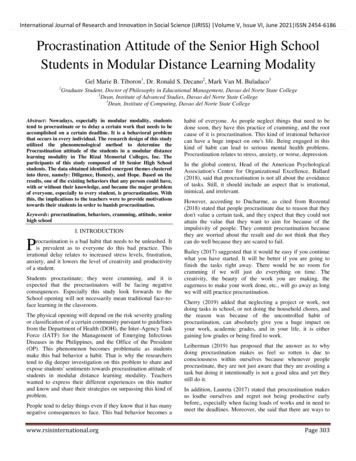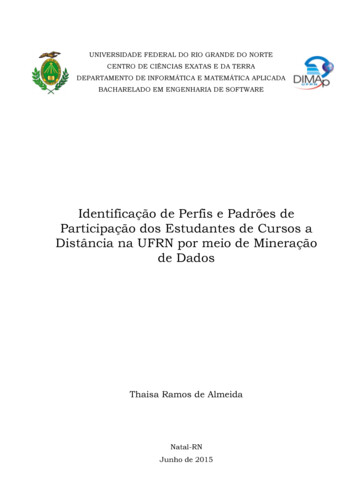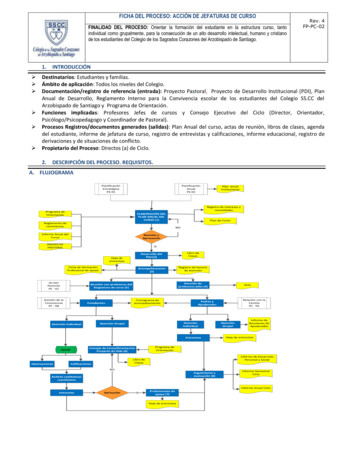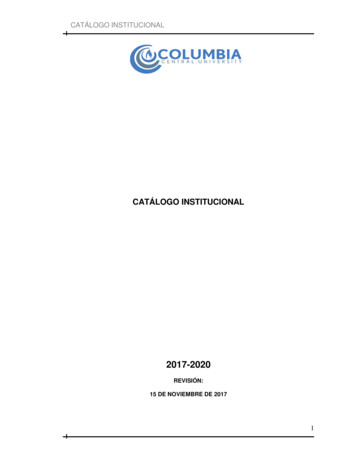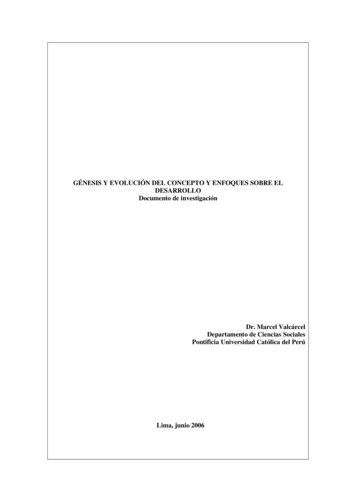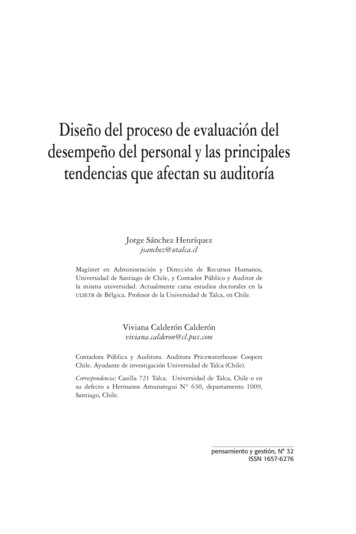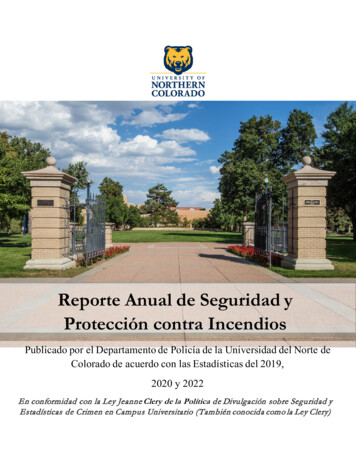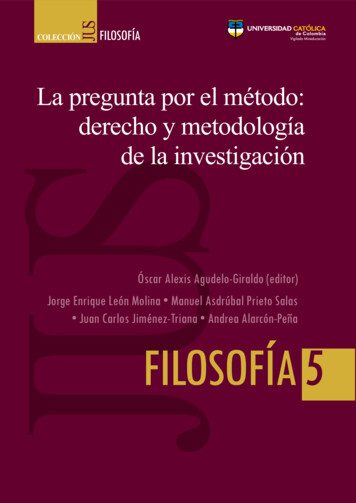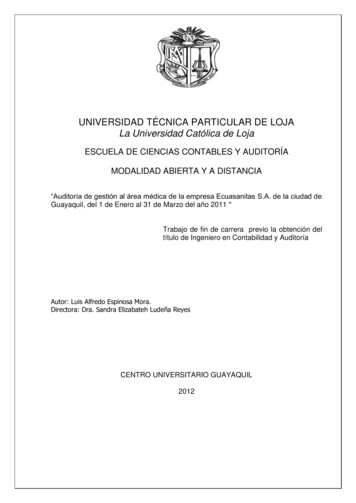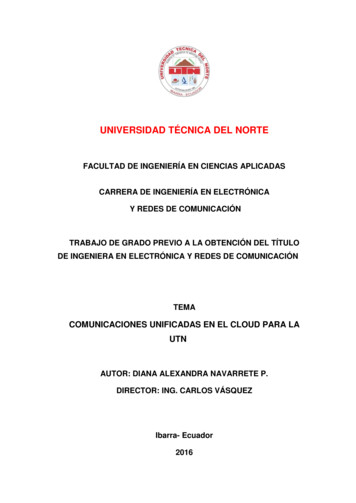
Transcription
UNIVERSIDAD TÉCNICA DEL NORTEFACULTAD DE INGENIERÍA EN CIENCIAS APLICADASCARRERA DE INGENIERÍA EN ELECTRÓNICAY REDES DE COMUNICACIÓNTRABAJO DE GRADO PREVIO A LA OBTENCIÓN DEL TÍTULODE INGENIERA EN ELECTRÓNICA Y REDES DE COMUNICACIÓNTEMACOMUNICACIONES UNIFICADAS EN EL CLOUD PARA LAUTNAUTOR: DIANA ALEXANDRA NAVARRETE P.DIRECTOR: ING. CARLOS VÁSQUEZIbarra- Ecuador2016
Unified Communications in the cloud to the UTNDiana Alexandra Navarrete PaillachoFacultad de Ingeniería en Ciencias Aplicadas, Universidad Técnica del Norte, Av. 17 de Julio, Ibarra, Imbaburadanavarretep@utn.edu.ecAbstract. The present study identify alternative UnifiedCommunications, based on free software, determiningnecessary guidelines for the design of a UnifiedCommunications system, thus ensuring communication inthe institution and demonstrating a hosted in the cloud canprovide equally good performance and availability of theirservices.During the development of the project, an investigation ofplatforms in the Cloud made, services offered by unifiedcommunications, signaling protocols, codecs audio andvideo, servers for unified communications, softphones forvideo conferencing and software for instant messaging,taking into account the compatibility and availability onmobile devices and PCs.A comparative analysis of various platforms of UnifiedCommunications such us Elastix, Cisco and Avaya weremade, In the same way it was done with cloud computingplatforms like OpenStack, Eucalyptus and OpenNebula.The current status of the data network of the Universitywas studied, in order to determine whether thecharacteristics and resources can support unifiedcommunications services, as well as it was dimensioned theresources each service demands, in terms of bandwidth andusers, and a plan of extensions and users for UnifiedCommunications services was s, plataforms, Open Stack, instantmessaging, e-mail, Videoconference.1. IntroductionThe Technical University of the North has a maincampus and some places nearby annexs to the same, withinwhich they operate 6 faculties, various units anddepartments with a large number of persons who form partof the human talent which hinders communications withinand outside the campus. Account with a data networkdeployed toward all campuses, which provides variousservices. By what you want between all the campus and itsextensions have permanent communication, so that whenyou send a message or notification this for deployment toall devices that handle the user, guaranteeing the deliveryof the same and optimizing the resources that you have.With regard to concepts of unified communications, itis necessary to obtain information about their functionalityand the way in which will be integrated services, in thesame way with cloud computing, investigate job mode, theinteractivity with the user and the availability of theservices that are hosted in the cloud. To take the decisionthat software is to be used both for the communicationserver as for the accommodation of the services in thecloud, there will be a comparative analysis of the Amazon,OpenStack platforms, in the case of cloud and Elastix andSolutions for Cisco Unified Communications, based onstandard analysis of requirements for software developmentISO IEC IEEE 29148, analyzing certain factors andfeatures such as system requirements, security, reliabilityof information, activities and processes, goals andobjectives, integration of services and infrastructuresupport and limitations.Once it have the clear definitions and concepts of therole, applicability of both unified communications as ofcloud computing, as well as the software for eachapplication, will prepare a design of how it will bestructured the communications architecture taking intoaccount the services that will integrate, as are: videoconferencing, instant messaging, email. You willimplement the design of the architecture with the videoconferencing services, mail, instant messaging, and in thesame way the platform integration and unifiedcommunications server hosted in the cloud, guaranteeingthe availability, quality of service, andindependence.Unified Communications lead the convergencebeyond the IP telephony, integrating presence, instantmessaging, unified messaging, Web conferencing andvideo conferencing, on a common platform accessible fromany media. Its advantages are evident in terms of increasedproductivity and faster decision making. The UnifiedCommunications implementation in the UTN seeks tointegrate existing solutions of communication with newsolutions available, taking advantage to turn cloudcomputing platforms. The focus of the project is aimed atproviding the services of Unified Communications in thecloud, so that deployed within and outside the campus.
2. Current situation of the universitynetwork and infrastructure designOnce you have reviewed the current status of thewireless network of the University were able todetermine the necessary requirements for the design of theunified communications project, which are listed below: That the network and its teams cover most of thefacilities within and outside the University toavoid inconveniences in the transmission of data. Bandwidth Control Management of Services. Control of latency, delay Allow the empowerment of ports that requireapplications There is a large number of servers that offerdifferent services to the client and generates trafficon the network so that it is considered necessaryto devise techniques of prioritization of traffic toensure the voice service and data. It is advisable to maintain a level of lowpercentage in regard to packet loss and avoidnetwork congestion.2.1 PLATFORM REQUIREMENTS It also considers the use of softphones in thepersonal computers of multiple users and ifnecessary on their Blackberry Smartphones, sothat they can access both to their email accounts,Messaging or make a video. Reduce the problems of failuresUsers Requirements Be able to access all the services are already sointernally between users on the network andexternal as are the different units attached to theUniversity. The services require user mobility in a transparentway, quick and without any disruption of thesame. Have a good quality and videoconferencing, aswell as ensure the delivery of packages both of themessaging and email. The communication must be acceptable and doesnot cause discomfort to the user. The server must be flexible to increase, change ordelete users, accounts, etc. Security is required in the integrity of theinformation in the records of the users. Availability of service when the customer requiresit.SOFTWARE REQUIREMENTS The software must be free or opensource, it must also be a trusted version,stable and that is not in evidencegathering stage. The system must be scalable to higherversions. Count with documents, magazines,articles, etc. on the part of the developers. Must support audio codec and video aswell as SIP extensions and IAX Management of the system either via httplocally and remotely, have securitymechanisms in what refers to the sshaccess.Requirements of Services32.2 SIZING OF COMPONENTS ANDSERVICESYou must take into account the following aspects: Number of extensions that are to beconnected to the central, in the case ofvideo call with softphones. The number of videoconferencingthrough the softphone which aims tooffer The type of codec to be used, both audioand video Emails accounts and dimensioning ofusers. Number of users interacting in the case ofinstant messaging, as well as the transferof files Bandwidth for a video call VoIP
It is important to take into account asignificant aspect, if you have a platformon which you intend to install Elastix ismust make performance tests with theitems mentioned above.The management and administration ofElastix is done by web access for ease inits graphical interface.2.3 SIZINGOFTHEUNIFIEDCOMMUNICATIONS SERVICEFor the dimensioning of the system is to take intoaccount certain parameters that will serve for the design ofthe system, the lists below:Capacity of the instance in the Cloud PlatformThe characteristics of the instance that were assign toaccommodate the Unified Communications Serverare: 1GB RAM Memory 10 GB Hard Disk 2-core processorThese features will allow testing to measure theperformance of the server and cloud platform, when testingwith a small group of users, these features are sufficient inthe case of instant messaging and email, because they donot have greater consumption of bandwidth, where this isnot the same with videoconferencing, since it consumesabout 1 Mbps per session, taking into account that thevideo is not of such high quality, which means thatsimultaneous video calls may be made but a limitednumber, this has to do with the audio and video codec youare using.In so far as it related to the number of users,extensions and mail accounts, will be compared with areal server, in which the values of number of usersranges between 500 and 1000 users.TABLE IAudio e(payload) PS)(MS)G.711641602050G.7298202050GSM13332050To perform the calculations of the bandwidth is goingto use the gsm codec, since it is the one that shows have thebest features for this design, due to having a compressionof 13 Kbit/s respectively, offers a good performance withrespect to the use of the CPU and is also enabled in Elastix,and making comparison with other codecs your bandwidthconsumption is less, another audio codec is the G.729, butthis codec requires the acquisition of license.In the case of video conference is going to use thecodec h.264 since it significantly increases the quality ofthe image with a technique for the valuation of themovement of the half-pixel, in addition it should beemphasized that the softphones support the codec h.264 , isthe case of Jitsi (in the case of PCs) and Voip by Antisip(inthe case of mobile devices), since that within theparameters of the videoconferencing is the mobility and theversion of Voip by Antisip is most appropriate in mobiledevices. You can also use softphones Zoiper and X-lite ifthe communication is 1:1, it should be stressed that thesehandle h.263 which is available in the same way in Elastix,only that significantly increases the jitter and echo whenthey bind more people to the conferenceEthernetIPUDPRTPVOICE18 bytes20 bytes8 bytes12 bytes33 bytesFigure 1. VoIP Frame FormatTotal package size (link layer header) header/UDP/RTP) (size of the payload of voice).(IP (18 20 8 12 33)Voice Bandwidth 91 bytes𝑃𝑃S (number of packages 𝑡𝑥/𝑠𝑒𝑔) (transmission ratecodec)/ (𝑝𝑎𝑦𝑙𝑜𝑎𝑑) (13 kbps)/ (33x8) (13000)/ (264)
50 ppsVideo Bandwidth: 1 Mbps 1000 KbpsN. userss: 22Bandwidth (total package size) (𝑃𝑃𝑆)Total Bandwidth 1036 Kbps x 22Bandwidth 22792 Kbps 22 Mbps (91x8)*(50) (728)*(50) 36400 bpsTraffic Flow 36 KbpsA Amount of video calls in one hour * duration ofeach callVideo BandwidthTable IICapacity of the emailH.264 video codecVideocodecResolutionMaximumload speedofideo(kbps)Minimum loadingspeed of ideo(kbps)H.2641280x72025015To have a sample of 22 users, you can calculate thecapacity of the e-mail server for that number, because eachuser is assigned a quota of 500 MBQuota 500 MBNo. Users 22Storage capacity 500 * 22 11 GBAB 1000 KbpsInstant Messaging BandwidthResolution 1280x720Fps 30In this case select a minimum bandwidth, sincemaking a comparison with the actual values that requires aconference, at least we should have a bandwidth of 3 Mbps.In this case was used a calculator bandwidth for video, inwhich entering values similar to the requirements wereobtained an estimated bandwidth needed to have quality inthe videoconference.This is an approximate data provided by the JabberSoftware Foundation. Therefore: 1000 concurrent userswould consume 1000KBps. [4] That is to say that each userconsumes around 1 Kbps, according to criteria andevidence of experts working with Jabber.2.4 IDENTIFICATION OF INTEGRATEDSERVICES1) EMAILAn e-mail system is made up of several components.The main ones are the Mail User Agent (MUA), the MTA(Mail Transfer Agent) and the MDA (Mail Delivery Agent)Figure 2. Bandwidth calculator for videoAudio Bandwidth: 36 Kbps5
Figure 3. Components of an electronic mail systemThe Mua is the program with which it is generatedthe email and usually resides on the client computer, forexample Microsoft Outlook, the Mozilla Thunderbird,among others.The MTA is who, via the SMTP protocol, receivesthe message from the MUA and decide who to deliver it. Ifthe mail is destined to another domain, the MTA will try tocontact the mail server for that domain and will transfer themessage using the same SMTP protocol. If the mail isdestined for a local domain, the MTA transferred internallythe message to the MDA who in turn shall be responsibleto place it in the respective mailbox. (Landívar, 2008)Users can access their mailboxes using the MUA,but through protocols POP and/or IMAP, which must beactive in the mail server.Elastix used as MTA to Postfix and as MDA to CyrusIMAP, who also provides the services of POP and IMAP.Likewise, with the Elastix comes by default a webmailinterface call RoundCube Mail, the same that can be usedas MUA.Openfire is a complete instant messaging system thatallows us to have an instant messaging service rich infeatures such as file transfer, messages other gateways IM, among others.Openfire account with a user-friendly webadministration interface that allows us to performadministrative tasks in an intuitive way.Remarkable features: User-friendly interface of Web Administration Expandable functionality via plugins Interaction with other networksmessaging as Gtalk, Yahoo Allows you to create different working groups Creating and Managing Users Registration of user sessions Maximum number of active sessionsofinstant Conference roomsSoftware for email Applications: spark in the case of Windows andLinux, and Xabber for mobile devicesIn order to handle the email accounts on a mobiledevice was chose for Android Roundcube, through whichyou can manage our email account. File Transfer Voice Codecs: G711, G722, alaw, Speex Video codecs: H264,h263, H263P,H2612) Instant MessagingSoftware for instant messagingElastix based its instant messaging functionality inthe software Openfire that works on the basis of theprotocol XMPP (originally known as Jabber)XMPP protocol (Jabber)The fact that you use XMPP in Elastix gives us agreat advantage because XMPP is a standard and there arecurrently many client applications compatible with thisprotocol. In summary, there are many options at the time ofchoosing a internal messaging client.XMPP is a protocol proven, open, extensible,generally accepted, secure and based on XML. These aresome of the reasons why he was chose to be part ofElastix. (Landívar, 2008)OpenfireThe software used to manage accounts of instantmessaging is called spark in the case of work in a PC, andfor mobile devices is selected the software Xabber, becauseit uses the XMPP protocol, in such a case, any softwarethat use this protocol may be used.3) videoconferencing Use of SIP protocol Configuring SIP Extensions Softphones: X-lite, Zoiper, Jitsi Another alternative is that Jitsi has some servicesattachments such as the association of a XMPPaccount, which was already configured onOpenfire, and can be used in this softphone.
Consists in adding the XMPP account to Jitsi, andthis in turn is compatible with spark, theadvantage of Jitsi is that it allows us to createsessions or conferences and add more contactswithin the same video conferencing.Software for video conferencing In the case of video conference you can work withX-lite, Jitsi For mobile devices will be used the softwareZoiper or Voip by Antisip, for testing wasconducted with the softphones x-lite and zoiper,but to have a better quality and video when thereare more participant and you want thatvideoconferencing is interactive used thesoftphone and Voip by Antisip Jitsi.2.5 FACTORS THAT INFLUENCE THEBANDWIDTH OF A NETWORK OFVOICE AND DATATable IIITo determine the presence or level of criticality of theparameters mentioned above, is to capture the traffic in anetwork point remotely and on ends of the network; towhich it makes use of a sniffer, in this case use will bemade of the software tool called Wireshark, for being oneof the most powerful analyzers for its ease of use, userfriendly interface, a large number of features and themanagement of multiple protocols.3. ResultsOnce installed the communication server in the cloudplatform and also configured their services such as: email,instant messaging and video conferencing, the tests to beperformed are intended to corroborate that has acompliance of design which is raised and that all serviceswork properly and are adapted to the needs andrequirements before you raised. We will analyze thefollowing cases: Bandwidth consumption for each application Jitter Packet Loss Traffic flow in peak hours Memory consumption and CPUen the cloud serverand on the server ElastixFactors that influence the bandwidtha) EmailPerformance indicators of voice and dataIn a network of voice and data services is necessary toprovide acceptable levels of access and minimumparameters of quality of service for which it is required toestablish indicators about the performance of each service.These indicators can be: Acceptable level of throughput (bps) Acceptable level of delay (ms) less than 150ms(ITU-T Recommendation G.114) Jitter less than 100ms Packet loss less than 1%In the tests of sending mail there is no greaterproblem, nor too consumption of resources, because this isnot a connection-oriented service, I just need to know if Iam or not the message regardless of time to review theother person.What can be measured is the space that is beingoccupied according to the registered users, taking intoaccount that each user is assigned between 500 and 1000MB.Figure 4. Proof of sending mail7
The server displays the protocols that are running inthis case which uses the Jabber instant messaging, as wellas its rate of transfer rate and packages, which are used tomeasure the bandwidth.TABLE IVEmail Verification TestsRouncube a Roundcube Roundcube a Outlook Roundcube,Gmail, etc.OutlookaHotmail, b) Instant MessagingOnce registered users are applicable to add contacts,for which there is a process of acceptance and confirmationby the users.Depending on the number of characters that are sentthrough the conversation or if you send attachments,bandwidth consumption will be minimal as shown in thetables later.Figure 7. Server monitoring ExindaTABLE VIVerification tests of Instant MessagingPC to PC PC to Mobile MobileMobileFigure 5. Spark and Xabber Usersto It was found that the response time is instantly in the3 cases mentioned above, there is no loss of data, whichmust be emphasized is that from any extension of theUniversity until the university campus the invitation to theconversation that you normally tends to delay but inthousandths of a second.C) VideoconferencingThe softphone works with Aryans codec in this case isused the gsm codec and in turn the codec h.263 Forvideo, however depending on the bandwidth you havewithin the network, the distortion of the image, the jitter orecho, Iran by varying their values.Likewise for measurements of performance can benoted that the capacity of the memory and the processorconsumption increased considerably, and even more timeto add participants to the conferenceFigure 6. Conversation between users
Figure 10. Registration of PC Users- MobileOnce the connection is established you can observe thatend-to-end there is a good communication and quality ofthe signal.Figura 8. Videoconferencing Exinda ServermonitoringConsumption of ApplicationsAs they were making the calls and sending messageseither by mail or instant messaging what more increasedwas the capacity of the RAM in the CPU consumption ismaintained at an average of 50%, which is acceptable, butit should be emphasized that only did the test with only afew users, that is why resizing the values of the processorand the memory, 2 CPU and 4GB RAMFigure 11. PC users JitsiFigure 12. Mobile users- Voip by AntisipFigura 9. Consumo de Memoria y CPUFeatures inside of the videoconference this thedesktop sharing, for example to make an exposure or thatthe user also has the option to manage or edit.Connectivity TestsFigure 13. Mobile Desktop Comparticion- Voip byAntisip9
Taking into account that the network of the Universitydoes not have policies on quality of service, the tests thatwere conducted with each service in a 50% in the case ofvideo conference showed the deterioration of quality ineach call, due to packet loss ranged from 5 to 17% persession, and jitter exceeded the average value where atransmission is acceptable, for the rest of the services theconnectivity and availability of the same result wassatisfactory.Figure 14. PC Desktop Sharing4. ConclusionsWe have implemented a Unified Communicationsplatform in the cloud, in order to improve communicationwithin the institution and improving the processes, whichmade it possible to expand a series of services that workunder the free software platform.Was the design of the Unified CommunicationsSystem, defined a sizing the service, both of software,hardware, users, as well as of each service according toparameters proposed, in this case bandwidth, machinescapacity, performance, traffic flow, etc.Infrastructure as a service that provides the platformfor cloud computing, brings other types of cloud when youinstall the Unified Communications Server, it is the casethat the communication server indirectly is providingsoftware as a service known as SAAS, which the user onlymakes use of the software and the application withouthaving to worry about maintenance of infrastructure orservers.Installed the Unified Communications services in thetwo platforms in the cloud, as due to the incompatibility ofsignaling protocols used for videoconferencing in OpenStack, worked with Open Nebula in which thevideoconferencing service operates correctly according tothe benefits and features that handles the videoconference.Using the tool Wireshark is carried out a procedurefor capturing packets, which tested the performance andconnectivity of the platform and the services, respectively,with the obtaining of the reports generated by the serverExinda which belongs to the University was observed ontraffic that generates each service with the purpose ofvalidating whether it complies with the requirements ofdimensioning of the same and the characteristics of thedesign.Due to the optimization of resources and deploymentof services, the virtualization of the same, has markedtrend, allowing the administration of the infrastructureitself, reducing deployment costs and the consumption ofresources that generates each machine hosted in the Cloud.AcknowledgmentsIt is essential to thank people who formed part of thisresearch, the Project Working Group of Cloud Computingof the career of Electronic Engineering andCommunication Networks belonging to the Faculty ofEngineering in Applied Sciences. The teachers in charge ofthe project Ing. Edgar Maya and Ing. Carlos Vasquez whohelped and formed part of the development of this researchBibliographical References[1]Arévalo, J. M. (2011). Universidad Rey Juan Carlos. Obtenidode Cloud Computing: fundamentos, diseño y ndle/10115/5945/MemoriaTFMFINAL-2.pdf?sequence 1&isAllowed y[2] ausandovoip.blogspot.com/2011 01 01 archive.html[3] cisco/web/support/LA/7/73/73295 bwidthconsume.html[4] Jabber, Mensajeria instananea Libre. (s.f.). Obtenido dehttps://www.jabberes.org/node/501[5] Landívar, E. (2008). Comunicaciones unificadas con Elastix (Vol.II). Quito, Ecuador: no definido.[6] Villalon, J. L. (s.f.). Security Artwork. Obtenido otocolos-detransporte/[7] -comunicaciones-unificadas/Diana Navarrete was born in SanGabriel-Carchi. Completed his secondarystudies at the Colegio Nacional Jose JulianAndrade. He studied at the TechnicalUniversity of the North, belonged to theIEEE Student Branch.
Bandwidth for a video call VoIP TABLEIt is important to take into account a significant aspect, if you have a platform on which you intend to install Elastix is must make performance tests with the . Bandwidth calculator for video Audio Bandwidth: 36 Kbps Video Bandwidth: 1 Mbps 1000 Kbps N. userss: 22
